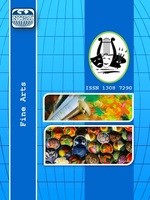ARTISTIC PLANT REPRESENTATION TECHNIQUES IN LANDSCAPE ARCHITECTURE
In all the artistic branches, "abstraction" is a common concept. Abstraction is the formation of objects that exist in nature and the information about these objects in the intellectual dimension, undertaking new meanings. In other words, abstraction is the interpretation of reality in a creative way. The objective of the present study is to determine the way abstraction is perceived in landscape architecture studies. In the study, how the plant displays used in Landscape Architecture works could be abstracted artistically. In the first stage, the visuals of selected plant species were examined by the authors based on size, form and texture, and artistic abstract representations were designed using different geometric forms. In the second phase, a survey was conducted on the designed artwork with 50 experts in the fields of architecture, landscape architecture, interior architecture, fine arts and painting. In the survey, the participants were asked to evaluate the artwork from an artistic perspective. At this stage, adjective pairs were provided to the experts and the representations were rated based on these attributes. For this purpose, a survey with the 5-point scale Semantic Differential Scale was determined as the method of this study. Finally, artistic plant representations expressed in abstraction were predominantly described with attributes such as creative, original, modern, etc.
Anahtar Kelimeler:
Art, Landscape Architecture, Abstraction, Plant Representation, Creativity
___
- • Atalay, R., (2007). Brancusi’nin Özelinde Heykel Sanatında Soyutlama. Anadolu Sanat Dergisi, Sayı:18, ss:101-106.
- • Bulat, M., (2014). Modern Sanatta Soyutlama, Atatürk Üniversitesi Yayınları, Erzurum, 117-131.
- • Deussen, O., (2003). A framework for geometry generation and rendering of plants with applications in landscape architecture. Landscape and Urban Planning, 64, 105–113.
- • Edgü, F., (1986). Şimdi Saat Kaç Denemeler. Ada Yayınları, İstanbul.
- • Evans, L., (1996). The New Complete Illustration Guide: The Ultimate Trace File for Architects, Designers, Artists, and Students. Van Nostrand Reinhold, New York.
- • Holton, M., (1994). Strands, gravity and botanical tree imagery. Computer Graphics Forum, 13(1), 57–67 (Eurographics Association).
- • Kurdoğlu, B.C., Karasah, B., Sarı, D., Yılmaz, H. and Kamer Aksoy, Ö., (2008). Bitkilendirme Tasarımı Eğitiminde Üç Boyutlu Anlatım Teknġklerinin Önemi Ve Değerlendirilmesi Üzerine Örnek Bir Çalışma. Artvin Çoruh University, Faculty of Forestry Journal, 9(1-2), 44-62.
- • Lynton, N., (1991). Modern Sanatın Öyküsü, Remzi Kitapevi, İstanbul.
- • Oppenheimer, P.E., (1986). Real-time Design and Animation of fractal plants and trees. In: SIGGRAPH’86 Conference Proceedings, ACM SIGGRAPH. 55–64.
- • Osgood, C., (1975). Cross-cultural Universals of Affective Meaning. University of Illinois Press, Urbana.
- • Schumann, J., Strothotte, T., Raab, A., and Laser, S., (1996). Assessing the Effect of Non-photorealistic Images in Computer-Aided Design. In: Proceedings SIGCHI’96 Conference ACM Human Factors in Computing Systems. ACM Press, pp:35–41, 13–15.
- • Thomson G., (1979). İnsanın Özü. Panel Yayınevi. İstanbul.
- • Walker, T.D., (1991). Planting Design. Van Nostrand Reinhold. New York.
- • Weber, J. and Penn, J., (1995). Creation and Rendering of Realistic Trees. In: SIGGRAPH’95 Conference Proceedings, ACM SIGGRAPH. pp:119–128.
- • Worringer, W., (1995). Soyutlama ve Özdeşleyim Remzi Kitabevi, İstanbul.
- • Yıldırım, B.T., (2000). Bitki Materyali I. Basılmamış Ders Notları. Ege Üniversitesi Ziraat Fakültesi Peyzaj Mimarlığı Bölümü, İzmir.
- Başlangıç: 2009
- Yayıncı: E-Journal of New World Sciences Academy
Sayıdaki Diğer Makaleler
MÜZİKSEL İŞİTME OKUMA ve YAZMA EĞİTİMİNİN KEMAN EĞİTİMİNE ETKİSİ
Büşra İnci Şendurur, Gamze Elif Tanınmış
GÖRSEL SANATLAR EĞİTİMİNDE BİLİMSEL ARAŞTIRMA YÖNTEMLERİ DERSİ VE MAKALE YAZMA SÜRECİ
KAMUSAL ALANLARDA VERİ KÜLTÜRÜ: VIDEO MAPPING
ARTISTIC PLANT REPRESENTATION TECHNIQUES IN LANDSCAPE ARCHITECTURE
